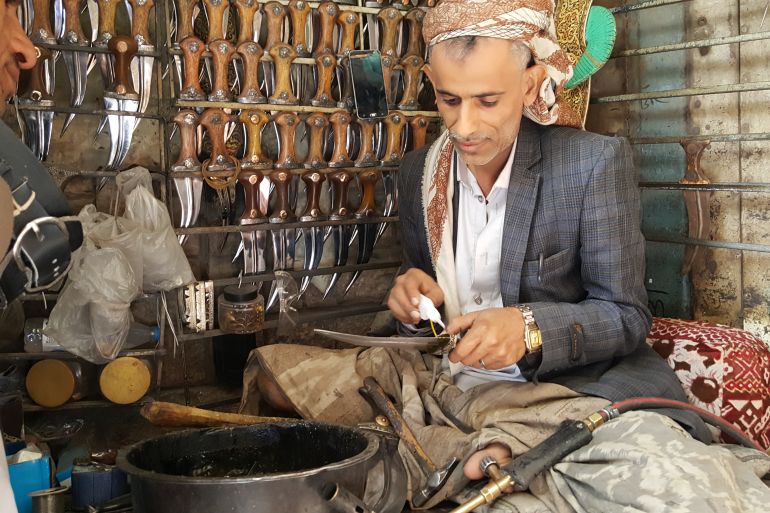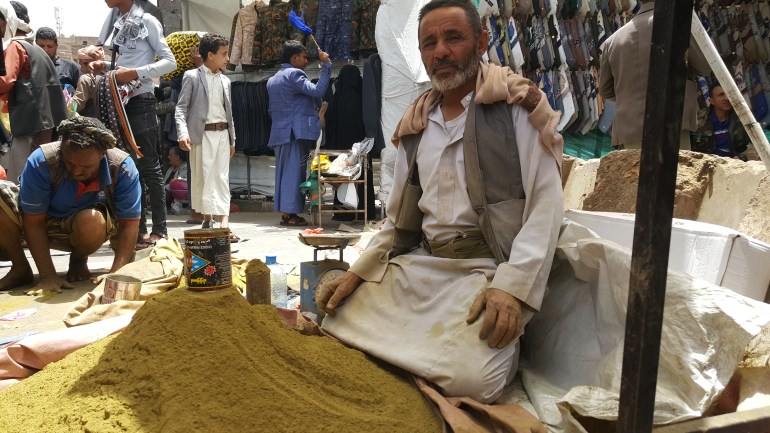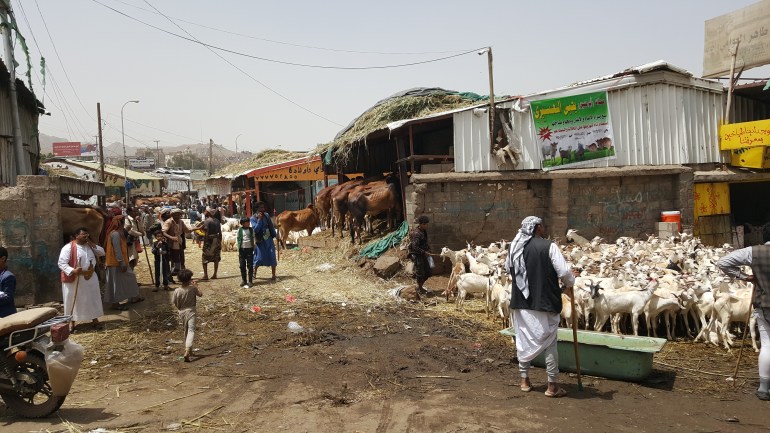Jambiyas and henna: War does not stop Yemeni preparations for Eid
A uneasy truce has brought relative quiet to Yemen, but people are still struggling to afford their Eid traditions.

Sanaa, Yemen – Outside Bab al-Yaman, the historic entrance to the Old City of Sanaa, there are no signs of war.
Markets are packed with people from inside and outside the capital buying gifts for the upcoming Eid al-Adha holiday, such as ceremonial daggers and henna, and sheep to be sacrificed.
Keep reading
list of 3 itemsCar bomb kills at least six in Yemen’s Aden, officials say
Yemeni currency devaluation persists, despite new leadership
Eid al-Adha, the most important Muslim religious festival, begins on Friday evening.
Abdul-Raqeeb al-Samey was buying a dagger, known as a jambiya and worn by Yemeni men as part of their traditional clothing, for his 14-year-old son Mohammed.
“Yemenis have worn a jambiya during Eid since the time of our great-grandparents,” al-Samey, who works as a plumber, explained to Al Jazeera.
“The jambiya has been a part of our history for a long time. People have been wearing similar knives since the Himyarites,” he added, referring to an ancient pre-Islamic Yemeni kingdom.
Al-Samey, like many people who live and work in Sanaa, is planning on celebrating Eid in his home village.
For al-Samey, that means a trip across Yemen’s front lines to Taiz governorate, in the centre of the country. Even with a United Nations-backed truce between Yemen’s warring sides in place since April, the journey is treacherous.
Negotiations over access to the city of Taiz, one of Yemen’s largest, remain a stumbling block in talks between the Yemeni government and the Houthi rebels.
Government-held areas of Taiz, the majority of the city, are blockaded by the Houthis, forcing people to travel instead through dangerous mountain roads.
Yemeni warring sides have been negotiating reopening roads in Taiz, where cutting the roads has been separating families living in Houthi-held areas and government-held areas pushing them to travel through dangerous mountainous roads.
But the Houthis have so far only offered to reopen small feeder roads, rather than the main access road to the city, as the government is demanding.
The UN-sponsored negotiations have stalled with the Houthis only offering to reopen feeder roads, while the government insists they must reopen a main road.
Jambiya hilts
The jambiya has long been thought of as a symbol of masculinity.
The curved daggers, worn on an embroidered belt can cost thousands of dollars, depending on the intricacy of the designs, and the material the dagger’s hilt is made of.
Waheeb Saif, owner of a large jambiya shop near Bab al-Yaman, sells several types of jambiya hilts.
“The best Yemeni-made hilts are Saiyfani, Ozeiry, al-Mosawaey, al-Zuraf, and al-Mahbashi,” said Saif. “The median prices range between five million Yemeni riyals [$9,000] and six million Yemeni riyals [$11,000]. The highest price is 10 million Yemeni riyals [$18,000] for the best type of jambiya, the Saiyfani.”
But for many Yemenis, in the middle of a war and economic crisis, those prices are unaffordable.
“Sales were better before the war as people had regular salaries; now, there are customers asking about prices, but they don’t buy as they can’t afford the prices,” Saif told Al Jazeera while sitting next to his jambiyas on display.
“I inherited this profession from my father at the age of 16, and he also inherited it from my grandfather,” Saif noted.
But, with globalisation, the old, and expensive methods of making jambiyas are threatened by cheaper imitators, often made in China, and sometimes from plastic.
“We can’t call for the Chinese jambiyas to be banned, because they are cheap and help poor Yemenis to buy them, if they can’t afford the Saiyfani or Ozeiry jambiyas,” Saif said.

‘The night of henna’
At the southern side of Bab Al-Yaman, Nasser al-Harazy is sat in front of a pile of henna – a dye used to draw intricate body designs – for sale.
He is surrounded by lots of other henna sales, but tells customers, “al-henna al-hali endi”, or “the best henna is with me”.
“My customers come from Ibb and Taiz,” al-Harazy told Al Jazeera. “Men and women buy from me. These are my best days to sell henna because it is Eid and hundreds of people get married.”
Al-Harazy explained that the henna he sells comes from his village up in the mountains of Haraz, west of Sanaa. The village, Badyat Al-Henna, is named after the dye.
“Henna is not used during Eid alone, women also use it for wedding parties and have a special event called the ‘night of henna’, when henna is put on the bride’s hands and legs, before she is taken to her groom’s house,” al-Harazy said, as a woman wearing a traditional Sanaani robe ordered a pot of henna.

Sacrifice in Qaryat Al-Qabil
Just to the east of the Old City of Sanaa sits Sanaa’s biggest livestock market, Nuqum, named after its location.
Salem Omar al-Dhabiah says he has been travelling from Al-Marawiah in Hodeidah governorate to Sanaa since the 1970s to sell hundreds of sheep ahead of every Eid Al-Adha in the Nuqum market.
However, this year, he has not brought along as many sheep as usual. Instead of the 500 or 1,000, he would bring in a normal year, he only has 150.
Sitting under a tree while his sons negotiate prices with customers, al-Dhabiah told Al Jazeera that he sells the smallest sheep for 30,000 Yemeni riyals ($60) and the biggest for 170,000 Yemeni riyals ($300).
Al-Dhabiah said the prices of sheep this year are higher than last year because of a “lack of monsoon rains” that have caused farmers to sell sheep before the summer because they were unable to feed them until Eid.
“Calves are very expensive and rare this year – only God knows the reason,” said customer Ali Mosleh al-Rajawi as he left the market followed by his grandchildren following him. “This time last year, the market was full of so many calves you couldn’t enter it.”
Eid Al-Adha is celebrated by Muslims across the globe as a way of marking the Islamic belief that God tested Ibrahim (Abraham) by ordering him to sacrifice his son, Ismail (Ishmael).
Ismail was then replaced with a sheep, which was sacrificed instead.
Al-Rajawi said he sacrifices five to 10 sheep every year to share among the 26 members of his extended family.
“This year, I have only three big billy goats, which are not enough, so I am here today to buy ‘tabai’,” al-Rajawi told Al Jazeera, using a Sanaani dialect word for a calf.
But, al-Rajawi complained, he was not able to find any calves at a reasonable price.
Al-Rajawai is heading to Qaryat Al-Qabil, a village north of Sanaa where he is originally from, to spend Eid.
He is planning on sacrificing a goat himself, and then dividing the meat into three portions.
“One will be a gift for relatives, friends and neighbours, and the second will be for the poor people in the village,” al-Rajawi said. “And the third will be for my family to eat.”